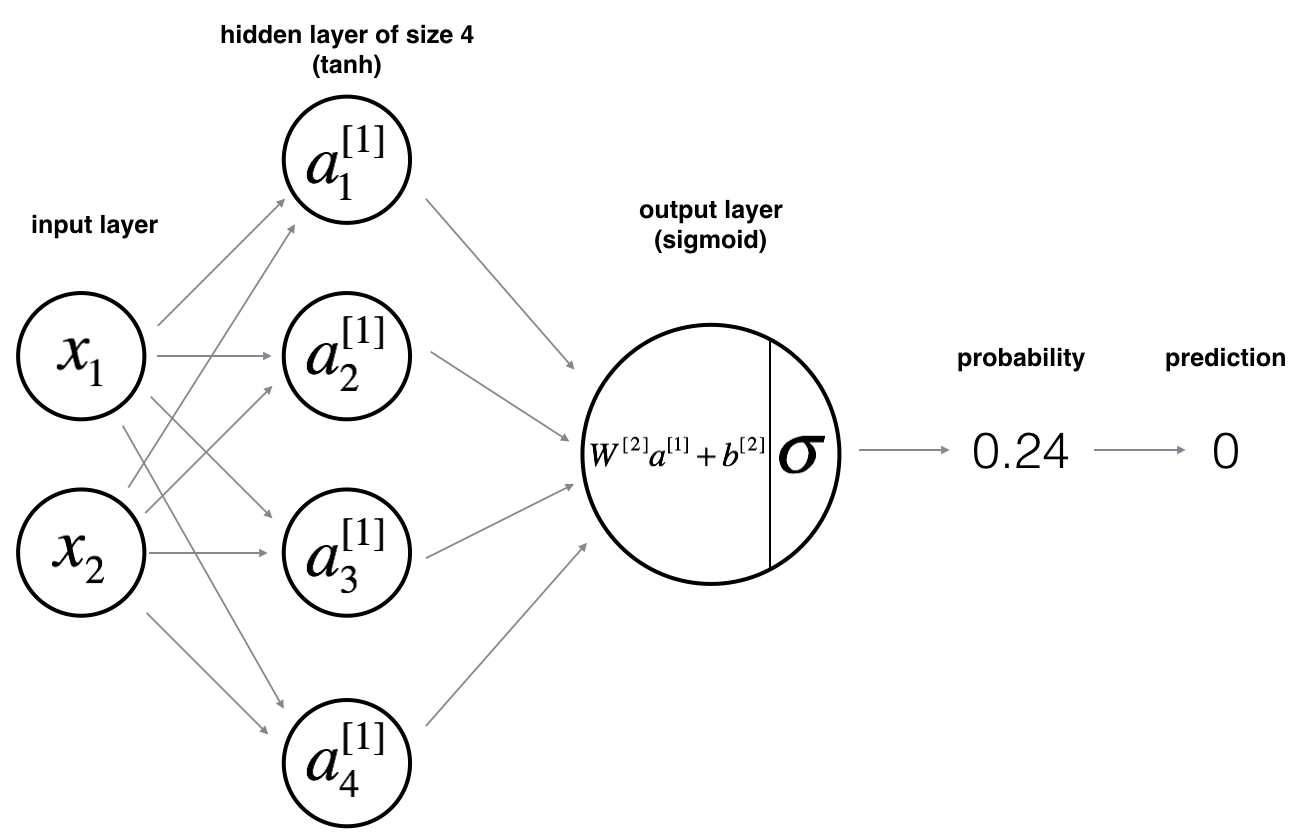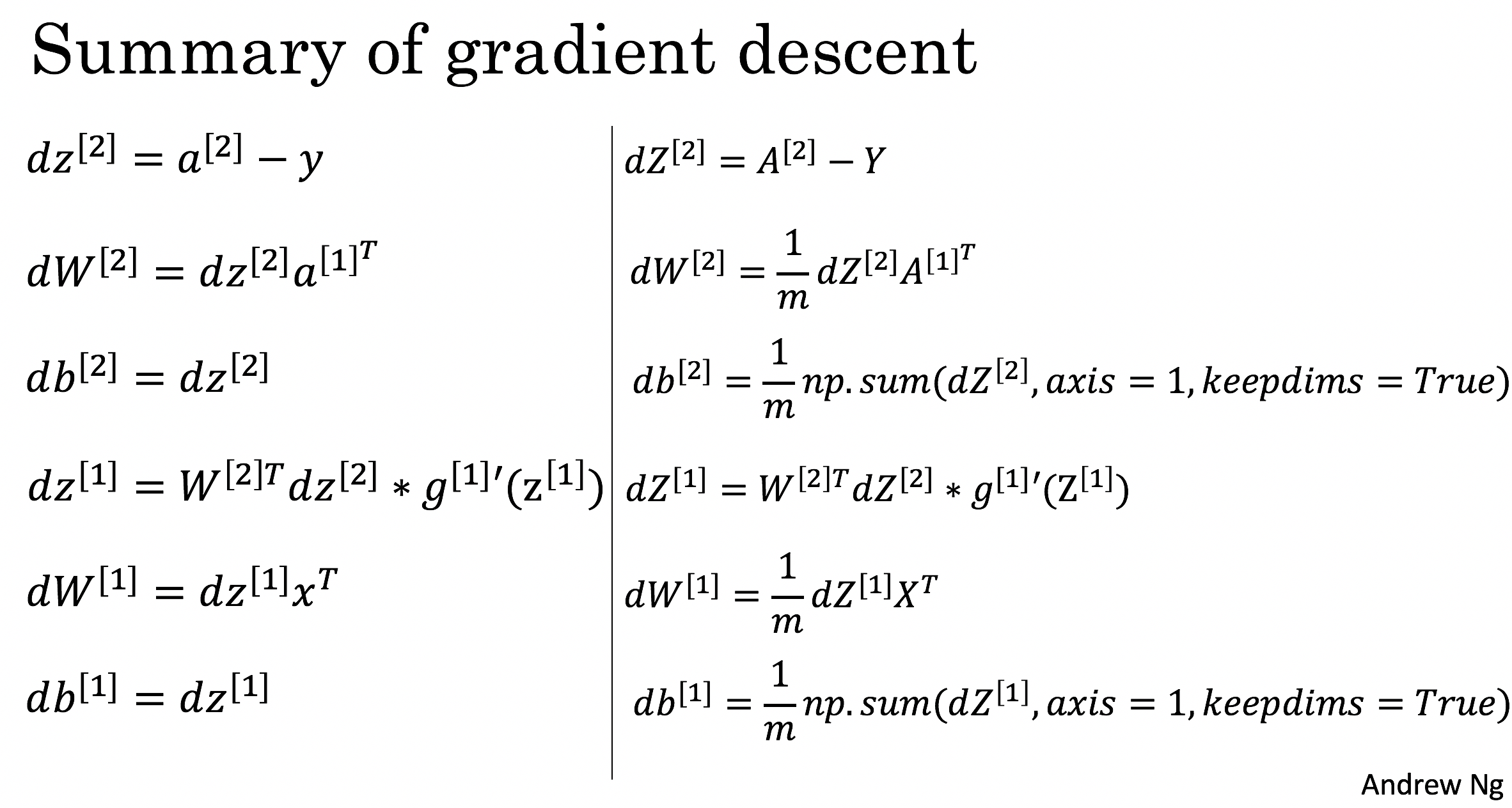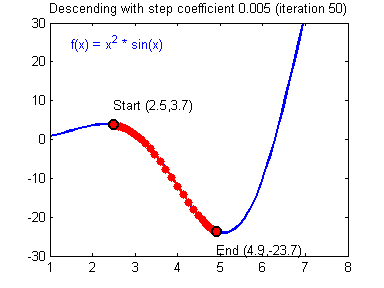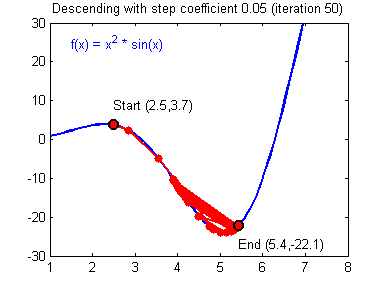吴恩达深度学习第1课第3周编程作业记录(2分类1隐层nn)
2分类1隐层nn, 作业默认设置:
- 1个输出单元, sigmoid激活函数. (因为二分类);
- 4个隐层单元, tanh激活函数. (除作为输出单元且为二分类任务外, 几乎不选用 sigmoid 做激活函数);
- n_x个输入单元, n_x为训练数据维度;
总的来说共三层: 输入层(n_x = X.shape[0]), 隐层(n_h = 4), 输出层(n_y = 1).
import 和预设置
# Package importsimport numpy as npimport matplotlib.pyplot as pltfrom testCases import *import sklearnimport sklearn.datasetsimport sklearn.linear_modelfrom planar_utils import plot_decision_boundary, sigmoid, load_planar_dataset, load_extra_datasets%matplotlib inlinenp.random.seed(1) # set a seed so that the results are consistent
4 - Neural Network model
Here is our model:

Mathematically:
For one example \(x^{(i)}\):
\]
\]
\]
\]
\]
Given the predictions on all the examples, you can also compute the cost \(J\) as follows:
\]
Reminder: The general methodology to build a Neural Network is to:
1. Define the neural network structure ( # of input units, # of hidden units, etc).2. Initialize the model's parameters3. Loop:- Implement forward propagation- Compute loss- Implement backward propagation to get the gradients- Update parameters (gradient descent)
You often build helper functions to compute steps 1-3 and then merge them into one function we call nn_model(). Once you've built nn_model() and learnt the right parameters, you can make predictions on new data.
4.1 - Defining the neural network structure
# GRADED FUNCTION: layer_sizesdef layer_sizes(X, Y):"""Arguments:X -- input dataset of shape (input size, number of examples)Y -- labels of shape (output size, number of examples)Returns:n_x -- the size of the input layern_h -- the size of the hidden layern_y -- the size of the output layer"""### START CODE HERE ### (≈ 3 lines of code)n_x = X.shape[0] # size of input layern_h = 4n_y = Y.shape[0] # size of output layer### END CODE HERE ###return (n_x, n_h, n_y)
4.2 - Initialize the model's parameters
# GRADED FUNCTION: initialize_parametersdef initialize_parameters(n_x, n_h, n_y):"""Argument:n_x -- size of the input layern_h -- size of the hidden layern_y -- size of the output layerReturns:params -- python dictionary containing your parameters:W1 -- weight matrix of shape (n_h, n_x)b1 -- bias vector of shape (n_h, 1)W2 -- weight matrix of shape (n_y, n_h)b2 -- bias vector of shape (n_y, 1)"""np.random.seed(2) # we set up a seed so that your output matches ours although the initialization is random.### START CODE HERE ### (≈ 4 lines of code)W1 = np.random.randn(n_h, n_x) * 0.01b1 = np.zeros((n_h, 1))W2 = np.random.randn(n_y, n_h) * 0.01b2 = np.zeros((n_y, 1))### END CODE HERE ###assert (W1.shape == (n_h, n_x))assert (b1.shape == (n_h, 1))assert (W2.shape == (n_y, n_h))assert (b2.shape == (n_y, 1))parameters = {"W1": W1,"b1": b1,"W2": W2,"b2": b2}return parameters
4.3 - The Loop
注意, 若换激活函数,有两个地方需要改:
- forward_propagation()中 A1 = np.tanh(Z1)处;
- backward_propagation()中 dZ1中 1 - np.power(A1, 2) 处.
\]
# GRADED FUNCTION: forward_propagationdef forward_propagation(X, parameters):"""Argument:X -- input data of size (n_x, m)parameters -- python dictionary containing your parameters (output of initialization function)Returns:A2 -- The sigmoid output of the second activationcache -- a dictionary containing "Z1", "A1", "Z2" and "A2""""# Retrieve each parameter from the dictionary "parameters"### START CODE HERE ### (≈ 4 lines of code)W1 = parameters["W1"]b1 = parameters["b1"]W2 = parameters["W2"]b2 = parameters["b2"]### END CODE HERE #### Implement Forward Propagation to calculate A2 (probabilities)### START CODE HERE ### (≈ 4 lines of code)Z1 = np.dot(W1, X) + b1A1 = np.tanh(Z1)Z2 = np.dot(W2, A1) + b2A2 = sigmoid(Z2)### END CODE HERE ###assert(A2.shape == (1, X.shape[1]))cache = {"Z1": Z1,"A1": A1,"Z2": Z2,"A2": A2}return A2, cache
# GRADED FUNCTION: compute_costdef compute_cost(A2, Y, parameters):"""Computes the cross-entropy cost given in equation (13)Arguments:A2 -- The sigmoid output of the second activation, of shape (1, number of examples)Y -- "true" labels vector of shape (1, number of examples)parameters -- python dictionary containing your parameters W1, b1, W2 and b2Returns:cost -- cross-entropy cost given equation (13)"""m = Y.shape[1] # number of example# Compute the cross-entropy cost### START CODE HERE ### (≈ 2 lines of code)logprobs = np.multiply(np.log(A2), Y) + np.multiply(np.log(1 - A2), 1 - Y)cost = -np.sum(logprobs)/m### END CODE HERE ###cost = np.squeeze(cost) # makes sure cost is the dimension we expect.# E.g., turns [[17]] into 17assert(isinstance(cost, float))return cost
反向传播时用到的公式:

# GRADED FUNCTION: backward_propagationdef backward_propagation(parameters, cache, X, Y):"""Implement the backward propagation using the instructions above.Arguments:parameters -- python dictionary containing our parameterscache -- a dictionary containing "Z1", "A1", "Z2" and "A2".X -- input data of shape (2, number of examples)Y -- "true" labels vector of shape (1, number of examples)Returns:grads -- python dictionary containing your gradients with respect to different parameters"""m = X.shape[1]# First, retrieve W1 and W2 from the dictionary "parameters".### START CODE HERE ### (≈ 2 lines of code)W1 = parameters["W1"]W2 = parameters["W2"]### END CODE HERE #### Retrieve also A1 and A2 from dictionary "cache".### START CODE HERE ### (≈ 2 lines of code)A1 = cache["A1"]A2 = cache["A2"]### END CODE HERE #### Backward propagation: calculate dW1, db1, dW2, db2.### START CODE HERE ### (≈ 6 lines of code, corresponding to 6 equations on slide above)dZ2 = A2 - YdW2 = np.dot(dZ2, A1.T)/mdb2 = np.sum(dZ2, axis=1, keepdims=True)/m# tanh的导数 1-A1^2# 若换激活函数,有两个地方需要改# 1. forward_propagation()中 A1 = np.tanh(Z1)处# 2. 就是这里backward_propagation()中 dZ1中 1 - np.power(A1, 2) 处dZ1 = np.multiply(np.dot(W2.T, dZ2), 1 - np.power(A1, 2)) # <--dW1 = np.dot(dZ1, X.T)/mdb1 = np.sum(dZ1, axis=1, keepdims=True)/m### END CODE HERE ###grads = {"dW1": dW1,"db1": db1,"dW2": dW2,"db2": db2}return grads
# GRADED FUNCTION: update_parametersdef update_parameters(parameters, grads, learning_rate = 1.2):"""Updates parameters using the gradient descent update rule given aboveArguments:parameters -- python dictionary containing your parametersgrads -- python dictionary containing your gradientsReturns:parameters -- python dictionary containing your updated parameters"""# Retrieve each parameter from the dictionary "parameters"### START CODE HERE ### (≈ 4 lines of code)W1 = parameters["W1"]b1 = parameters["b1"]W2 = parameters["W2"]b2 = parameters["b2"]### END CODE HERE #### Retrieve each gradient from the dictionary "grads"### START CODE HERE ### (≈ 4 lines of code)dW1 = grads["dW1"]db1 = grads["db1"]dW2 = grads["dW2"]db2 = grads["db2"]## END CODE HERE #### Update rule for each parameter### START CODE HERE ### (≈ 4 lines of code)W1 -= learning_rate*dW1b1 -= learning_rate*db1W2 -= learning_rate*dW2b2 -= learning_rate*db2### END CODE HERE ###parameters = {"W1": W1,"b1": b1,"W2": W2,"b2": b2}return parameters
4.4 - Integrate parts 4.1, 4.2 and 4.3 in nn_model()
# GRADED FUNCTION: nn_modeldef nn_model(X, Y, n_h, num_iterations = 10000, print_cost=False):"""Arguments:X -- dataset of shape (2, number of examples)Y -- labels of shape (1, number of examples)n_h -- size of the hidden layernum_iterations -- Number of iterations in gradient descent loopprint_cost -- if True, print the cost every 1000 iterationsReturns:parameters -- parameters learnt by the model. They can then be used to predict."""np.random.seed(3)n_x = layer_sizes(X, Y)[0]n_y = layer_sizes(X, Y)[2]# Initialize parameters, then retrieve W1, b1, W2, b2. Inputs: "n_x, n_h, n_y". Outputs = "W1, b1, W2, b2, parameters".### START CODE HERE ### (≈ 5 lines of code)parameters = initialize_parameters(n_x, n_h, n_y)W1 = parameters["W1"]b1 = parameters["b1"]W2 = parameters["W2"]b2 = parameters["b2"]### END CODE HERE #### Loop (gradient descent)for i in range(0, num_iterations):### START CODE HERE ### (≈ 4 lines of code)# Forward propagation. Inputs: "X, parameters". Outputs: "A2, cache".A2, cache = forward_propagation(X, parameters)# Cost function. Inputs: "A2, Y, parameters". Outputs: "cost".cost = compute_cost(A2, Y, parameters)# Backpropagation. Inputs: "parameters, cache, X, Y". Outputs: "grads".grads = backward_propagation(parameters, cache, X, Y)# Gradient descent parameter update. Inputs: "parameters, grads". Outputs: "parameters".parameters = update_parameters(parameters, grads)### END CODE HERE #### Print the cost every 1000 iterationsif print_cost and i % 1000 == 0:print ("Cost after iteration %i: %f" %(i, cost))return parameters
4.5 Predictions
Reminder: predictions = \(y_{prediction} = \mathbb 1 \text{{activation > 0.5}} = \begin{cases}
1 & \text{if}\ activation > 0.5 \\
0 & \text{otherwise}
\end{cases}\)
As an example, if you would like to set the entries of a matrix X to 0 and 1 based on a threshold you would do: X_new = (X > threshold)
# GRADED FUNCTION: predictdef predict(parameters, X):"""Using the learned parameters, predicts a class for each example in XArguments:parameters -- python dictionary containing your parametersX -- input data of size (n_x, m)Returnspredictions -- vector of predictions of our model (red: 0 / blue: 1)"""# Computes probabilities using forward propagation, and classifies to 0/1 using 0.5 as the threshold.### START CODE HERE ### (≈ 2 lines of code)A2, cache = forward_propagation(X, parameters)predictions = (A2[0] > 0.5) # [ True False True] 而不是 [1 0 1]### END CODE HERE ###return predictions
使用模型
# Build a model with a n_h-dimensional hidden layer# 模型经训练后,最终得到 parameters = W2, b2, W1, b1parameters = nn_model(X, Y, n_h = 4, num_iterations = 10000, print_cost=True)# Plot the decision boundary# 新数据 x 和训练好的参数 parameters 送入 predict() 后, 经过一个前向, 得到A2,# 再经threshold得到预测结果.# Print accuracypredictions = predict(parameters, X)print ('Accuracy: %d' % float((np.dot(Y,predictions.T) + np.dot(1-Y,1-predictions.T))/float(Y.size)*100) + '%')
4.6 - Tuning hidden layer size (optional/ungraded exercise)
plt.figure(figsize=(16, 32))hidden_layer_sizes = [1, 2, 3, 4, 5, 10, 20]for i, n_h in enumerate(hidden_layer_sizes):plt.subplot(5, 2, i+1)plt.title('Hidden Layer of size %d' % n_h)parameters = nn_model(X, Y, n_h, num_iterations = 5000)plot_decision_boundary(lambda x: predict(parameters, x.T), X, Y)predictions = predict(parameters, X)accuracy = float((np.dot(Y,predictions.T) + np.dot(1-Y,1-predictions.T))/float(Y.size)*100)print ("Accuracy for {} hidden units: {} %".format(n_h, accuracy))
最后顺便把作业里的两个动画(表现学习率设置不合适导致发散,反过来收敛)也弄上来:


吴恩达深度学习第1课第3周编程作业记录(2分类1隐层nn)的更多相关文章
- 吴恩达深度学习第4课第3周编程作业 + PIL + Python3 + Anaconda环境 + Ubuntu + 导入PIL报错的解决
问题描述: 做吴恩达深度学习第4课第3周编程作业时导入PIL包报错. 我的环境: 已经安装了Tensorflow GPU 版本 Python3 Anaconda 解决办法: 安装pillow模块,而不 ...
- 吴恩达深度学习第2课第2周编程作业 的坑(Optimization Methods)
我python2.7, 做吴恩达深度学习第2课第2周编程作业 Optimization Methods 时有2个坑: 第一坑 需将辅助文件 opt_utils.py 的 nitialize_param ...
- 吴恩达深度学习第2课第3周编程作业 的坑(Tensorflow+Tutorial)
可能因为Andrew Ng用的是python3,而我是python2.7的缘故,我发现了坑.如下: 在辅助文件tf_utils.py中的random_mini_batches(X, Y, mini_b ...
- 吴恩达深度学习第1课第4周-任意层人工神经网络(Artificial Neural Network,即ANN)(向量化)手写推导过程(我觉得已经很详细了)
学习了吴恩达老师深度学习工程师第一门课,受益匪浅,尤其是吴老师所用的符号系统,准确且易区分. 遵循吴老师的符号系统,我对任意层神经网络模型进行了详细的推导,形成笔记. 有人说推导任意层MLP很容易,我 ...
- 【Deeplearning.ai 】吴恩达深度学习笔记及课后作业目录
吴恩达深度学习课程的课堂笔记以及课后作业 代码下载:https://github.com/douzujun/Deep-Learning-Coursera 吴恩达推荐笔记:https://mp.weix ...
- 吴恩达深度学习 反向传播(Back Propagation)公式推导技巧
由于之前看的深度学习的知识都比较零散,补一下吴老师的课程希望能对这块有一个比较完整的认识.课程分为5个部分(粗体部分为已经看过的): 神经网络和深度学习 改善深层神经网络:超参数调试.正则化以及优化 ...
- 深度学习 吴恩达深度学习课程2第三周 tensorflow实践 参数初始化的影响
博主 撸的 该节 代码 地址 :https://github.com/LemonTree1994/machine-learning/blob/master/%E5%90%B4%E6%81%A9%E8 ...
- cousera 吴恩达 深度学习 第一课 第二周 作业 过拟合的表现
上图是课上的编程作业运行10000次迭代后,输出每一百次迭代 训练准确度和测试准确度的走势图,可以看到在600代左右测试准确度为最大的,74%左右, 然后掉到70%左右,再掉到68%左右,然后升到70 ...
- Coursera 吴恩达 深度学习 学习笔记
神经网络和深度学习 Week 1-2 神经网络基础 Week 3 浅层神经网络 Week 4 深层神经网络 改善深层神经网络 Week 1 深度学习的实用层面 Week 2 优化算法 Week 3 超 ...
随机推荐
- 开发技巧(3-1)Eclipse查找关键字
1.选择资源目录->选择search-file菜单 2.在弹出的对话框中, 输入要[搜索的字符串],选择[selected resources],点击[search]按钮 3.搜索结果
- 一个适用于单页应用,返回原始滚动条位置的demo
如题,最近做一个项目时,由于页面太长,跳转后在返回又回到初始位置,不利于用户体验,需要每次返回到用户离开该页面是的位置.由于是移动端项目,使用了移动端的套ui框架framework7,本身框架的机制是 ...
- leetcode算法: Find All Duplicates in an Array
Given an array of integers, 1 ≤ a[i] ≤ n (n = size of array), some elements appear twice and others ...
- 老男孩python学习之作业一购物小程序
想学编程由来已久 始终没有个结果,痛心不已 如今再次捡起来,望不负期望,不负岁月 ......一万字的废话...... 先介绍一下我的自学课程吧 "路飞学城"的<python ...
- NetSNMP开源代码学习——小试牛刀
原创作品,转载请注明出处,严禁非法转载.如有错误,请留言! email:40879506@qq.com 题外话:技术越是古董级的东西,越是值得学习. 一. 配置 参考: http://www.cnbl ...
- Spark:将RDD[List[String,List[Person]]]中的List[Person]通过spark api保存为hdfs文件时一直出现not serializable task,没办法找到"spark自定义Kryo序列化输入输出API"
声明:本文转自<在Spark中自定义Kryo序列化输入输出API> 在Spark中内置支持两种系列化格式:(1).Java serialization:(2).Kryo seriali ...
- Spark:spark df插入hive表后小文件数量多,如何合并?
在做spark开发过程中,时不时的就有可能遇到租户的hive库目录下的文件个数超出了最大限制问题. 一般情况下通过hive的参数设置: val conf = new SparkConf().setAp ...
- Struts(二十三):使用声名式验证
Struts2工程中的验证分为两种: 1.基于XWork Validation Framework的声明式验证:Struts2提供了一些基于XWork Validation Framework的内建验 ...
- VMwaretools、共享文件夹、全屏
VMware12.1 + Ubuntu14.04 + win10专业版 设置 共享文件夹和解决Ubuntu全屏问题. 我实在不喜欢这种敲敲打打的工作,不喜欢这种有点无聊的配置环境.我喜欢 ...
- asp.net core 六 Oracle ORM
.netcore 中 Oracle ORM 在真正将项目移植到.netcore下,才发现会有很多问题,例如访问Oracle,问题出现的时间在2017年底 参考连接 ...
